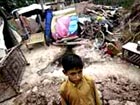| Videos | ? Latest |
|
? Feature | ? Sports | ? Your Videos |
Little media attention hurts Pakistan's recovery

It's being called a crisis of epic proportions. Nearly twenty million Pakistanis have been affected by the country's devastating floods. Yet the international media has provided little coverage of the tragedy. Why is this happening and how has it affected the recovery effort?
It's the kind of story that should have the world's attention. Wide-spread flooding along Pakistan's Indus river has slowly engulfed much of the country.
Rebecca Winthrop, Brookings Institute, said, "Millions of people, about 18.6, are affected. Bigger than Katrina and the tsunami all put together. It's a disaster of epic proportions."
Rebecca Winthrop,from the Brookings Institution, has followed the flooding for weeks.It began when heavy monsoon rains hit the northern part of the country sending a wall of water downstream.
Rebecca Winthrop, Brookings Institute, said, "A lot of people don't have bank accounts.All their assets might have been swept away."
"This massive flooding has covered 1/5 of Pakistan--about the size of the US state of Florida. It's destroyed roads, killed most of the Fall harvest and damaged more than one million homes."
But even as the disaster grew larger and larger -- the world media's interest didn't keep up.
Mark Jurkowitz, Pew Research Center, said, "I think the one word to describe the coverage of this is modest. Given the extent of the disaster and catastrophe."
Mark Jurkowitz helps run the Project for Excellence in Journalism at the Pew Research Center. He's been studying the media coverage for this tragedy and was surprised by his findings:the flooding story is the least covered major news event of 2010. For example -- while Haiti's earthquake got more than 40% media coverage -- Pakistan's flooding has received less than 5%.
That's especially significant because it could have a direct impact on the recovery effort.
Mark Jurkowitz, Pew Research Center, said, "To the extent that images that move the public like tragedy and death are not being seen—you’re not getting the emotions to open up your checkbook and give money."
And in fact -- that's exactly what's happening. Barely half of the 460-million dollars of requested relief aid has been received so far. Aid organizations like the American Red Cross are doing their part working with the Red Crescent.
Alex Mahoney, American Red Cross, said, "We're supporting their work to bring clean water and food and relief items like kitchen sets and tarps for shelter."
But the private donations are not coming in. Experts lay the blame on a variety of factors: from the low death toll to the fact that it's been a slow moving disaster. That could make this tragedy even worse.
Rebecca Winthrop, Brookings Institute, said, "It's very scary in terms of how the government is performing. It's not a stable country and this could be a tipping point."
With the monsoon rains still coming the flooding is expected to continue for several more weeks. But researchers at the Project for Excellence say media coverage already peaked -- meaning Pakistan may not have the world’s attention at the very moment it needs it the most.
 0
0 






